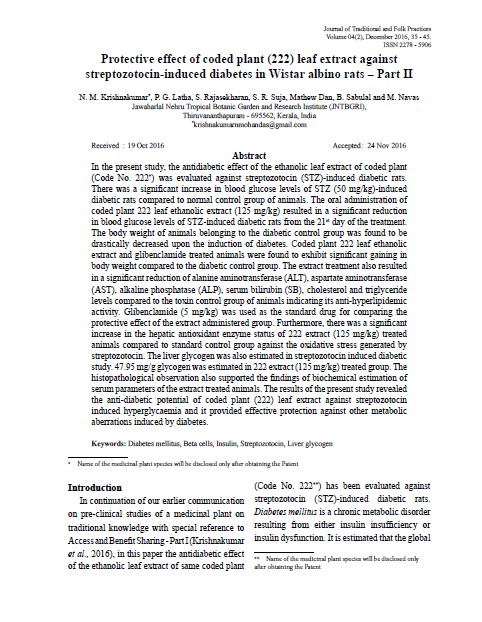Protective effect of coded plant (222) leaf extract against streptozotocin-induced diabetes in Wistar albino rats – Part II
Keywords:
Diabetes mellitus, Beta cells, Insulin, Streptozotocin, Liver glycogenAbstract
In the present study, the antidiabetic effect of the ethanolic leaf extract of coded plant (Code No. 222*) was evaluated against streptozotocin (STZ)-induced diabetic rats. There was a significant increase in blood glucose levels of STZ (50 mg/kg)-induced diabetic rats compared to normal control group of animals. The oral administration of coded plant 222 leaf ethanolic extract (125 mg/kg) resulted in a significant reduction in blood glucose levels of STZ-induced diabetic rats from the 21st day of the treatment. The body weight of animals belonging to the diabetic control group was found to be drastically decreased upon the induction of diabetes. Coded plant 222 leaf ethanolic extract and glibenclamide treated animals were found to exhibit significant gaining in body weight compared to the diabetic control group. The extract treatment also resulted in a significant reduction of alanine aminotransferase (ALT), aspartate aminotransferase (AST), alkaline phosphatase (ALP), serum bilirubin (SB), cholesterol and triglyceride levels compared to the toxin control group of animals indicating its anti-hyperlipidemic activity. Glibenclamide (5 mg/kg) was used as the standard drug for comparing the protective effect of the extract administered group. Furthermore, there was a significant increase in the hepatic antioxidant enzyme status of 222 extract (125 mg/kg) treated animals compared to standard control group against the oxidative stress generated by streptozotocin. The liver glycogen was also estimated in streptozotocin induced diabetic study. 47.95 mg/g glycogen was estimated in 222 extract (125 mg/kg) treated group. The histopathological observation also supported the findings of biochemical estimation of serum parameters of the extract treated animals. The results of the present study revealed the anti-diabetic potential of coded plant (222) leaf extract against streptozotocin induced hyperglycaemia and it provided effective protection against other metabolic aberrations induced by diabetes.


